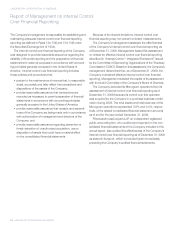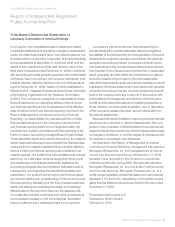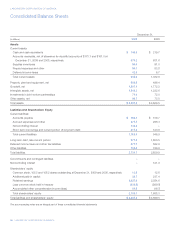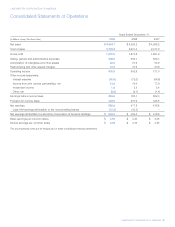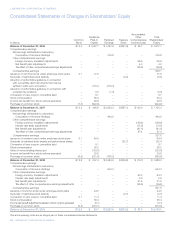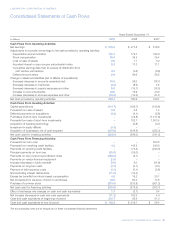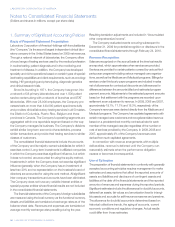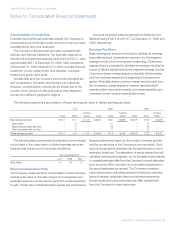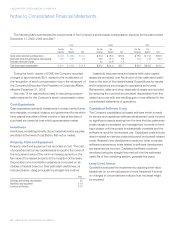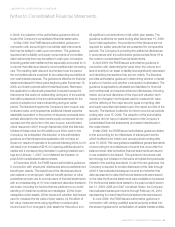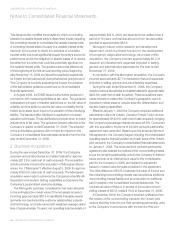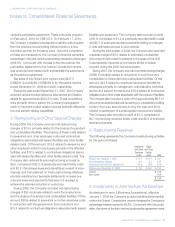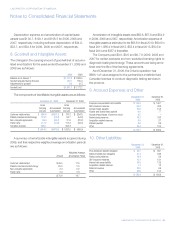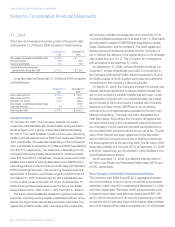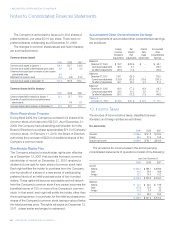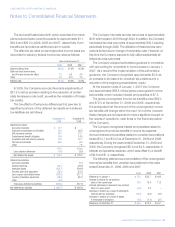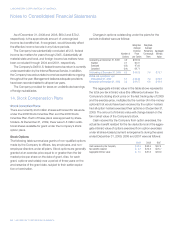LabCorp 2009 Annual Report Download - page 46
Download and view the complete annual report
Please find page 46 of the 2009 LabCorp annual report below. You can navigate through the pages in the report by either clicking on the pages listed below, or by using the keyword search tool below to find specific information within the annual report.44 LABORATORY CORPORATION OF AMERICA
LABORATORY CORPORATION OF AMERICA
Notes to Consolidated Financial Statements
Fair Value of Financial Instruments
The carrying amounts of cash and cash equivalents, accounts
receivable, income taxes receivable and accounts payable are
considered to be representative of their respective fair values
due to their short-term nature. The fair market value of the zero-
coupon subordinated notes, based on market pricing, was
approximately $374.6 and $650.7 as of December 31, 2009
and 2008, respectively. The fair market value of the senior
notes, based on market pricing, was approximately $645.2 and
$539.7 as of December 31, 2009 and 2008, respectively. As of
December 31, 2009 and 2008, the estimated fair market value
of the Company’s variable rate debt of $486.4 and $491.1,
respectively, was estimated by calculating the net present value
of related cash flows, discounted at current market rates.
Effective January 1, 2008, the Company adopted authoritative
guidance in connection with fair value measurements for financial
assets and liabilities. The guidance clarifies the definition of fair
value, prescribes methods for measuring fair value, establishes
a fair value hierarchy based on the inputs used to measure fair
value and expands disclosures about fair value measurements.
The three-tier fair value hierarchy, which prioritizes the inputs
used in the valuation methodologies, is:
Level 1 – Valuations based on quoted prices for identical
assets and liabilities in active markets.
Level 2 – Valuations based on observable inputs other than
quoted prices included in Level 1, such as quoted prices
for similar assets and liabilities in active markets, quoted
prices for identical or similar assets and liabilities in markets
that are not active, or other inputs that are observable or
can be corroborated by observable market data.
Level 3 – Valuations based on unobservable inputs reflect-
ing the Company’s own assumptions, consistent with
reasonably available assumptions made by other market
participants. These valuations require significant judgment.
During 2009, the Company implemented authoritative
guidance for its nonfinancial assets and liabilities that are
remeasured at fair value on a non-recurring basis. The adop-
tion of the guidance did not impact the Company’s financial
position or results of operations; however, it could have an
impact in future periods. In addition, the Company may have
additional disclosure requirements in the event the Company
completes a significant acquisition or incurs impairment of the
Company’s assets in future periods.
Research and Development
The Company expenses research and development costs as
incurred.
New Accounting Pronouncements
In June 2009, the FASB established authoritative United States
generally accepted accounting principles (“GAAP”), codifying and
superseding all pre-existing accounting standards and literature.
This newly codified GAAP is effective for financial statements
issued for interim and annual periods ending after September 15,
2009. The Company has adopted the guidance without any
impact on the consolidated financial statements.
In December 2007, the FASB issued authoritative guidance
requiring all entities to report noncontrolling (minority) interests
in subsidiaries as equity in the consolidated financial statements.
The Company adopted the guidance as of January 1, 2009
and pursuant to the provisions of the literature, the presentation
and disclosure requirements have been applied retrospectively
for all periods presented. Due to the nature of the noncontrolling
interest put, the Company has not included the noncontrolling
interest in its Ontario joint venture in the equity section of the
accompanying consolidated balance sheets.
In December 2007, the FASB issued authoritative guidance
in connection with business combinations which was intended
to simplify existing guidance and converge rulemaking under
U.S. GAAP with international accounting rules. The guidance
applies prospectively to business combinations where the
acquisition date is on or after the beginning of the first annual
reporting period beginning on or after December 15, 2008.
The Company adopted the literature as of January 1, 2009,
and the Company began recording acquisitions in accordance
with the authoritative guidance. As a result, acquisition related
costs, primarily legal and other professional services, of $7.7
were included in selling, general and administrative expenses
for the year ended December 31, 2009.
In April 2009, the FASB issued authoritative guidance in
connection with accounting for assets acquired and liabilities
assumed in a business combination that arise from contingen-
cies. The guidance addresses application issues regarding the
initial recognition and measurement, subsequent measurement
and accounting, and disclosure of assets and liabilities arising
from contingencies in a business combination. Due to the fact
that the literature is applicable to acquisitions completed after
January 1, 2009 and the Company did not have any business
combinations with assets and liabilities arising from contingencies


